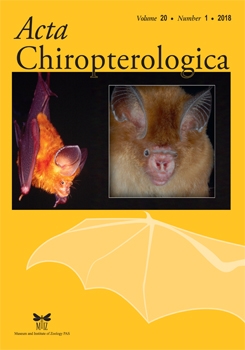Understanding foraging habits can be important for elucidating the ecology of any species and for designing appropriate conservation strategies. Common methods for determining bat diets, such as morphological examination of fecal material or recovery of prey fragments under feeding roosts, can be biased towards larger prey with harder exoskeletons by underestimating frequency/occurrence of smaller, softer bodied prey items. Our objectives were to determine prey selection for several common chiropteran species of bottomland hardwood forests in east Texas and to evaluate the use of DNA barcoding for dietary studies by comparing dietary composition to prey availability in four species of bats. We amplified the cytochrome coxidase subunit 1 gene from fecal samples collected from 19 bats of four species and identified arthropods by comparison to the Barcode of Life Data System database. We compared frequency of occurrence in fecal samples to frequency in concurrent night-flying insect sampling. We identified nine insect species from three orders consumed by Perimyotis subflavus, nine species from four orders consumed by Lasiurus seminolus, seven species from three orders consumed by Nycticeius humeralis, and 11 species from two orders consumed by Lasiurus borealis. Coleoptera was the most abundant order available by biomass, but beetles were never found in fecal samples from L. seminolus (n = 5) or L. borealis (n = 7) bats. However, Coleoptera comprised a substantial portion of prey identified from P. subflavus (n = 2) and N. humeralis samples (n = 5). Lepidopteran prey items were found in 13 of 19 bat fecal samples across all species but represented < 7% of arthropod biomass. Although dipteran species were a negligible portion (< 1%) of the available biomass, large numbers of dipterans were identified in fecal samples from all species of bats (13 of 19 samples across all species). Lasiurus seminolus and L. borealis may be selecting prey based on digestibility rather than availability; whereas, both N. humeralis and P. subflavus exhibited a more opportunistic approach to foraging. Based on comparison to other studies of bat diets, traditional techniques for analyzing diet from fecal samples are likely underrepresenting soft-bodied arthropods like dipterans.
How to translate text using browser tools
1 June 2018
Dietary Composition of Four Common Chiropteran Species in a Bottomland Hardwood Forest
Carla J. Weinkauf,
Christopher E. Comer,
Warren C. Conway,
Christopher Farrell
ACCESS THE FULL ARTICLE

Acta Chiropterologica
Vol. 20 • No. 1
June 2018
Vol. 20 • No. 1
June 2018
bats
diet
foraging theory
insects
molecular scatology
predator-prey interactions
trophic interactions




